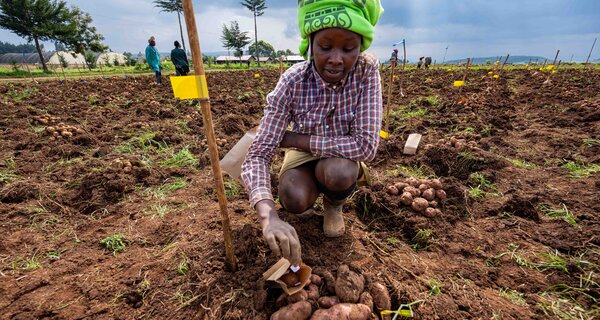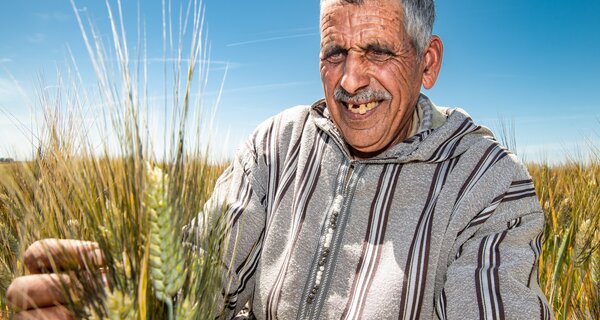Vietnam Recognizes its First-Ever Rice Variety Derived from Crop Wild Relatives

Shivali Sharma and Huynh Quang Tin review Nông Dân 1 at the seed club at Huyện Phụng Hiệpisi. Photo: Mike Major/Crop Trust
20 June 2025
Plant Breeders Innovate Against Climate Change
Vietnam's agriculture is at a crossroads. Extreme weather events, higher temperatures and unpredictable rainfall are putting pressure on the country’s food supply and disrupting farmers’ traditional practices.
But plant breeders and farmers are rising to these challenges by tapping into the unique genetic traits found in the wild relatives of the country’s most well-known and cherished crop – rice.
Last year, a rice variety derived from the crop’s wild relatives was the first of its kind to be registered for legal protection in Vietnam after more than a decade in development. The government’s Plant Variety Protection Office encourages plant breeders to develop improved plant varieties that help farmers adapt to changing conditions and rewards innovation that contributes to Vietnamese agriculture.
Crop wild relatives are undomesticated plants that are related to cultivated crops. Many are weedy, nondescript plants that wouldn’t catch your eye. However, some of them have developed survival mechanisms, encoded in their genes, in response to the harsh climatic conditions they have endured over thousands of years.
“If we can tap into the novel traits that are not found in domesticated varieties but are still found in their wild relatives, we can develop new, resilient crop varieties that will ensure food security, economic stability and environmental sustainability,” says Dr. Shivali Sharma, a pre-breeding and plant genetic resources specialist part of the BOLD (Biodiversity for Opportunities, Livelihoods and Development) Project that is strengthening food and nutrition security worldwide by supporting the conservation and use of crop diversity.

Huynh Quang Tin shows the rice collection supported by the Crop Trust at the genebank of Can Tho University. Photo: Mike Major/Crop Trust
Cultural Icon
Rice is a cultural staple in Vietnam, but also a source of income. The Southeast Asian country is among the world’s largest exporters of the crop, alongside India and Thailand. To maintain that status requires constant innovation.
The new rice variety that has been granted legal protection is named Nông Dân, which means “farmer” in English. Its story begins in 2011 under the Crop Trust’s Crop Wild Relatives Project.
Crossbreeding with wild relatives requires time and patience. Using traditional crop breeding methods, a team led by Dr. Susan McCouch at Cornell University selected and crossed wild rice from Bangladesh, China, Malaysia and Papua New Guinea with a modern elite variety. The new, advanced types of rice that the team developed were then shared with the International Rice Research Institute (IRRI) in the Philippines.
In December 2018, Huynh Quang Tin, a senior lecturer at Can Tho University’s Mekong Delta Development Research Institute, and his team acquired 200 of these rice types from the IRRI genebank. He then distributed them to 13 seed clubs across eight provinces in the Mekong Delta for evaluation. They identified a few promising, well-adapted plants that were collectively called Nông Dân.
“We actively involved farmers in the testing and decision-making process for selecting the best rice plants,” Tin says. “The on-farm selection process will really help in the quick, large-scale adoption by farmers.”

A farmer shares his rice preferences with members of the seed club at Dinh An, Lap Vo, Dong Thap. Photo: Mike Major/Crop Trust
Narrowing Down the Field
The farmers in the seed clubs liked what they grew in their fields, particularly Nông Dân 1 and 2. So, Tin and his team advanced those to the next chapter of the story.
Under the rice pre-breeding component of the BOLD Project – which launched in 2021 and is led by the Crop Trust – the team further evaluated them under diverse growing conditions in the Mekong Delta and in North and Central Vietnam.
The two farmer-preferred rices have now been given legal protection. Both varieties showed salt tolerance, good grain appearance, great yield potential, and excellent cooking quality. They also tasted good.
Nông Dân 1 is liked for its high productivity, light scent and blast resistance, while Nông Dân 2 ranked highly because of its good eating quality and desirable soft and sticky texture, along with high yield. Both varieties have wide adaptation, with excellent acceptance among farmers across different regions of Vietnam. Due to the varieties’ short duration – ranging from 95 to 99 days in the Mekong Delta and about 110 days in Central and North Vietnam – farmers can grow them up to three times in a year.

Farmers evaluate rice field trials in Gia Lai in Central Vietnam. Photo: Mike Major/Crop Trust
From PNG to Vietnam
Scientists say Nông Dân 1 may be getting some of those interesting qualities from a wild ancestor in its pedigree. It is derived from a cross between an elite rice variety and a wild rice called Oryza rufipogon, which was collected in Papua New Guinea and conserved in IRRI’s genebank.
O. rufipogon is a primary ancestor of our modern rice. The wild rice collected in Papua New Guinea showed salt tolerance, which interested the Vietnamese breeders. O. rufipogon isn’t cultivated. It sheds its seed before harvest and the grains are unpalatable anyway. In some parts of the United States, it is considered an invasive weed. But it’s that hidden toughness – those survival mechanisms in its genes– that rice breeders wanted to capture. The Nông Dân seeds will be evaluated soon for salt tolerance in Mekong Delta coastal areas.
“Many breeders are reluctant to use crop wild relatives in breeding programs,” Sharma says. “They fear that the wild relatives will cause their products to get worse, not better, at least initially. It may be difficult – and will take many years – to develop a new variety if wild relatives are involved in the crossing program. But it can be worth it.”
After a decade in development, the Nông Dân varieties show the great potential of crop wild relatives to advance climate-smart agriculture and farmer resilience. Though these varieties are not yet officially released, there is already demand for their seeds among farmers. To support this demand and early adoption, six promising elite lines of Nông Dân are now being multiplied by farmers at 30 sites in Vietnam.
“Our work in Vietnam clearly shows that crop wild relatives can be used to develop new varieties with traits farmers like, if we follow a systematic and focused breeding approach, and involve them throughout,” Sharma says.

Nông Dân 1 on trial. Photo: Mike Major/Crop Trust
Categories: For The Press, For Partners, BOLD, Rice, Climate Change, Food Security




